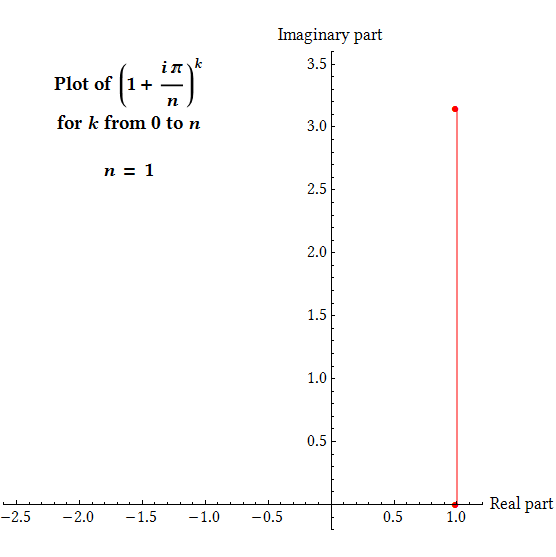Has anyone talked themselves into understanding Euler's identity a bit?
Solution 1:
The natural exponential function $w=e^z$ changes at a rate equal to its own value. So at $z=0$, we have $w=1$ and the rate of change $dw/dz$ is $1$. So (like Euler) consider an infinitely small but nonzero change in $z$, called $dz$. What is $dw=e^{0+dz}-e^0$ (i.e. the small change in $w$ when $z$ is changed by an infinitesimal amount $dz$)? Since the rate of change is $1$, we have $dw=dz$. In particular that means that if $dz = i\;dy$ where $dy$ is infinitely small and real, then it's moving from $1$ in the complex plane in a direction that is straight up or straight down, i.e. along the unit circle!.
Now suppose $e^a$ is some point on the circle and think about $e^{a + i\;dy}$ where $dy$ is infinitely small and real. Again, we want the rate of change to be equal to the value of the function, and that means the rate of change is that same point on the circle. Draw a vector from $0$ to that point; then $w$ is changing just that many times as fast as $z$ is changing. Now notice that the infinitely small quantity $i\;dy$ is a pure imaginary, and when you multiply by a pure imaginary you rotate $90^\circ$. That means $dw$ will be just as big in absolute value as $dy$ (since the absolute value of the derivative at that point is $1$, since the point is on the unit circle) but rotated $90^\circ$. That means instead of an arrow from $0$ out to a point on the circle, hitting the circle at a right angle, we've got an arrow tangent to the circle. In other words, as $z$ changes in the real direction, $w$ is changing in a direction tangent to the circle at the point where $w$ is located.
So as $y$ moves along the real line and $iy$ along the imaginary axis, $w$ moves alonng the circle! (And at the same speed.)
Solution 2:
Here's a viewpoint from the perspective: "Series made me do it."
If you take the definition of $e^x$ to be $\sum\limits_{n=0}^\infty \frac{x^n}{n!}$. Then $e^{ix} = \sum\limits_{n=0}^\infty \frac{(ix)^n}{n!}$. Keeping in mind $i^2=-1$, $i^3=-i$, etc., $e^{ix} = \sum\limits_{n\;\mathrm{even}} \frac{(ix)^n}{n!} + \sum\limits_{n\;\mathrm{odd}} \frac{(ix)^n}{n!} = \sum\limits_{k=0}^\infty \frac{(ix)^{2k}}{(2k)!} + \sum\limits_{\ell=0}^\infty \frac{(ix)^{2\ell+1}}{(2\ell+1)!}$ Thus $e^{ix} = \sum\limits_{k=0}^\infty \frac{(-1)^kx^{2k}}{(2k)!}+\sum\limits_{\ell=0}^{\infty} \frac{(-1)^\ell i x^{2\ell+1}}{(2\ell+1)!} = \cos(x)+i\sin(x)$ (recognizing the MacLaurin series of sine and cosine).
Therefore, $e^{i\pi}=\cos(\pi)+i\sin(\pi)=-1+i0=-1$.
So Euler says, "I couldn't help myself. Taylor series made me do it that way."
Solution 3:
One of the many equivalent characterizations / definitions of $e$ is this:
$$e^x=\lim_{n\to\infty}\left(1+\frac{x}{n}\right)^n$$
Therefore, to find $e^{i\pi}$, we can look at the quantity $$\left(1+\frac{i\pi}{n}\right)^n$$
for higher and higher values of $n$ and see what it approaches. Remember that multiplication of complex numbers works by adding angles and multiplying lengths, and observe that for any given $n$, we have $$\left\lvert1+\frac{i\pi}{n}\right\rvert>1,\qquad \mathrm{arg}\left(1+\frac{i\pi}{n}\right)>0$$ so that as the value of $k$ increases, the complex number $\bigl(1+\frac{i\pi}{n}\bigr)^k$ will rotate counterclockwise in the plane by equal steps while growing in magnitude geometrically, forming a spiral shape. For any given $n$, the value of $\bigl(1+\frac{i\pi}{n}\bigr)^k$ at $k=n$ is what we're interested in, as mentioned before.

(This animation was inspired by the animation from the Wikipedia page on Euler's identity. While mathematically great, I have long been unsatisfied with its quality - it is low resolution, not self-contained, and uses the default style of Mathematica. This is my endeavour to make a better version.)
My Mathematica code:
MyLabel[text_, location_] :=
Graphics[Text[Style[TraditionalForm[text],
FontFamily -> "Linux Libertine", 17, Bold], location]];
EulerPlot[n_] :=
Show[ListLinePlot[
Table[{Re[(1 + I Pi/n)^k], Im[(1 + I Pi/n)^k]}, {k, 0, n}],
PlotRange -> {{-2.6, 1.2}, {-0.2, 3.6}},
AspectRatio -> 1,
ImageSize -> {500, 500},
PlotStyle -> Red,
PlotMarkers -> Automatic,
AxesLabel -> {"Real part", "Imaginary part"},
AxesStyle ->
Directive[FontFamily -> "Linux Libertine", FontSize -> 15]],
MyLabel["Plot of \
\!\(\*FormBox[\(TraditionalForm\`\*SuperscriptBox[\((1 + \
\*FractionBox[\(i \[DoubledPi]\), \(n\)])\), \(k\)]\),
TraditionalForm]\)", {-1.6, 3.35}],
MyLabel["for \!\(TraditionalForm\`k\) from 0 to \
\!\(TraditionalForm\`n\)", {-1.6, 3.02}],
MyLabel[DisplayForm[
RowBox[{"\!\(TraditionalForm\`n\)", "\!\(TraditionalForm\` =\) ",
n}]], {-1.6, 2.65}]];
Export["animation.gif",
Table[EulerPlot[n], {n, {1, 2, 3, 4, 5, 6, 7, 8, 9, 10, 15, 20, 25, 30,
40, 50, 100}}], "DisplayDurations" -> {0.75}, ImageResolution -> 80]